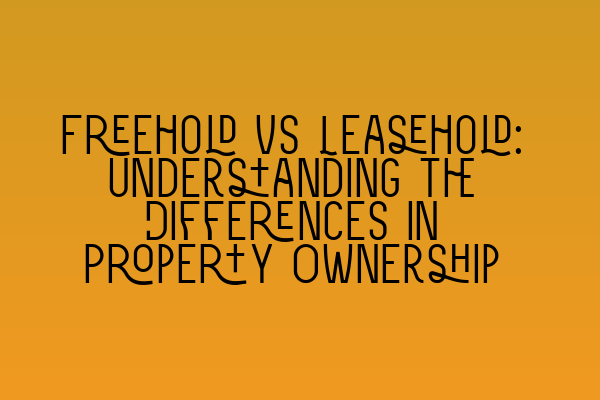Freehold vs Leasehold: Understanding the Differences in Property Ownership
When it comes to property ownership, understanding the differences between freehold and leasehold can be essential. Whether you are buying, selling, or managing a property, knowing the intricacies of each type of ownership can help you make informed decisions and avoid potential issues down the line.
What is Freehold?
Freehold ownership gives you full and absolute ownership rights over a property. When you own a property freehold, you own both the physical structure and the land it stands on. This means that you have complete control and can make decisions about the property without any restrictions from a landlord or external party.
As a freeholder, you are responsible for the maintenance and repair of the property. You also have the right to transfer or sell the property as you see fit.
Freehold properties are typically houses, although some flats and apartments can also be sold on a freehold basis. It’s important to note that freehold ownership is indefinite and does not have an expiration date.
What is Leasehold?
Leasehold ownership, on the other hand, is a form of ownership where you only have the right to use and occupy a property for a fixed period of time. The ownership of the property and the land it sits on remains with the landlord or freeholder.
A leasehold property is usually subject to a lease agreement, which outlines the terms and conditions of the lease, including the duration and any restrictions or obligations for the leaseholder. Common lease lengths are 99 years, 125 years, or 999 years, although the duration can vary.
Leaseholders typically pay ground rent, service charges, and may be required to seek permission from the freeholder for certain actions, such as major renovations or alterations to the property. It’s important to carefully review the terms of the lease agreement before purchasing a leasehold property to fully understand your rights and obligations as a leaseholder.
The Pros and Cons of Freehold and Leasehold
Each type of ownership comes with its own advantages and disadvantages, and it’s important to consider them before making a decision.
Advantages of Freehold:
- You have complete control and autonomy over the property.
- You are not subject to ground rent or service charges.
- You can make modifications and enhancements to the property without seeking permission.
- You have the potential to benefit from any increase in property value.
Disadvantages of Freehold:
- You are solely responsible for the maintenance and repair costs.
- You have limited legal protection if there are issues with neighboring properties.
- You bear all the risk if property values decrease.
Advantages of Leasehold:
- You may have access to communal areas, amenities, or services.
- Property maintenance and repairs may be the responsibility of the freeholder.
- You have the option to extend the lease in certain circumstances.
Disadvantages of Leasehold:
- You are subject to ground rent, service charges, and potential increases in these costs.
- You may need to seek permission for major renovations or alterations.
- Lease length can impact property value and mortgage eligibility.
- Leasehold properties can be more complex to sell or purchase.
Conclusion
Freehold and leasehold are two different types of property ownership, each with its own benefits and considerations. Understanding the differences between them is crucial when buying or selling a property or when dealing with property management matters.
If you require legal advice or assistance regarding freehold or leasehold property matters, contact SQE Property Law & Land Law for expert guidance and support.
Related Articles:
- SQE 1 Practice Exam Questions
- SQE 1 Practice Mocks FLK1 FLK2
- SQE 2 Preparation Courses
- SQE 1 Preparation Courses
- SRA SQE Exam Dates
